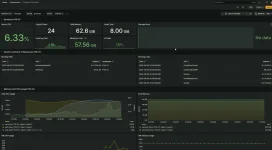I'm honestly starting to lose the will to live here—maybe I've just been staring at this for too long. At first glance, it looks like a Grafana issue, but I really don't think it is.
I was self-hosting an InfluxDB instance on a Proxmox LXC, which fed into a self-hosted Grafana LXC. Recently, I switched over to the cloud-hosted versions of both InfluxDB and Grafana. Everything's working great—except for one annoying thing: my Proxmox metrics are coming through fine except for the storage pools.
Back when everything was self-hosted, I could see LVM, ZFS, and all the disk-related metrics just fine. Now? Nothing. I’ve checked InfluxDB, and sure enough, that data is completely missing—anything related to the Proxmox host’s disks is just blank.
Looking into the system logs on Proxmox, I see this:
pvestatd[2227]: metrics send error 'influxdb': 400 Bad Request.
Now, you and I both know it's not a totally bad request—some metrics are getting through. So I’m wondering: could it be that the disk-related metrics are somehow malformed and triggering the 400 response specifically?
Is this a known issue with the metric server config when using InfluxDB Cloud? Every guide I’ve found assumes you're using a local InfluxDB instance with a LAN IP and port. I haven’t seen any that cover a cloud-based setup.
Has anyone run into this before? And if so... how did you fix it?
I was self-hosting an InfluxDB instance on a Proxmox LXC, which fed into a self-hosted Grafana LXC. Recently, I switched over to the cloud-hosted versions of both InfluxDB and Grafana. Everything's working great—except for one annoying thing: my Proxmox metrics are coming through fine except for the storage pools.
Back when everything was self-hosted, I could see LVM, ZFS, and all the disk-related metrics just fine. Now? Nothing. I’ve checked InfluxDB, and sure enough, that data is completely missing—anything related to the Proxmox host’s disks is just blank.
Looking into the system logs on Proxmox, I see this:
pvestatd[2227]: metrics send error 'influxdb': 400 Bad Request.
Now, you and I both know it's not a totally bad request—some metrics are getting through. So I’m wondering: could it be that the disk-related metrics are somehow malformed and triggering the 400 response specifically?
Is this a known issue with the metric server config when using InfluxDB Cloud? Every guide I’ve found assumes you're using a local InfluxDB instance with a LAN IP and port. I haven’t seen any that cover a cloud-based setup.
Has anyone run into this before? And if so... how did you fix it?


